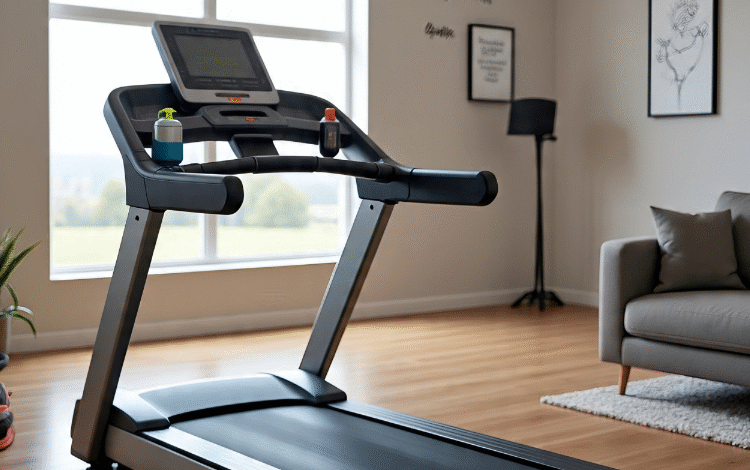Treadmill for Home: The Ultimate Guide to Choosing the Best One for Your Fitness Journey

In today’s fast-paced world, maintaining a healthy lifestyle is more important than ever. With busy schedules, finding time to go to the gym can be challenging. One of the best solutions for staying fit at home is investing in a treadmill for home use. Whether you’re a seasoned runner or just starting your fitness journey, a treadmill offers convenience, flexibility, and an effective way to burn calories, improve cardiovascular health, and strengthen muscles. In this guide, we will walk you through everything you need to know about choosing the best treadmill for your home, from essential features to maintenance tips, and answer some common questions.
Why Choose a Treadmill for Home Use
A treadmill for home use provides numerous benefits that make it an ideal addition to your fitness equipment collection. Here’s why:
Convenience and Accessibility
Having a treadmill at home means no more excuses. You can work out whenever it suits your schedule, whether it’s early in the morning, during lunch breaks, or late at night. There’s no need to worry about gym hours, crowded spaces, or weather conditions. This makes it much easier to stick to your fitness goals.
Comfort and Privacy
Working out at home provides the privacy and comfort that gyms often lack. You can enjoy your exercise routine in a controlled environment, without feeling self-conscious or distracted by others.
Cost-Effective Over Time
While purchasing a treadmill may be an initial investment, it pays off in the long run by eliminating the need for a gym membership. Additionally, you won’t have to deal with transportation costs or memberships fees.
Key Features to Consider When Buying a Treadmill
When purchasing a treadmill for home, it’s essential to keep certain features in mind to ensure you’re getting the best value and experience. Here are the key features to consider:
1. Motor Power
The motor’s power is one of the most critical factors in determining the treadmill’s performance. Look for a motor with at least 2.5 horsepower (HP) if you’re planning to run at high speeds or use it for extended periods. For walking or light jogging, a motor with 1.5 to 2 HP will suffice.
2. Running Surface and Belt
The size of the running surface is crucial for comfort and safety. A larger belt provides more room to run, especially if you’re taller or have a longer stride. Aim for a treadmill with a running surface of at least 20 inches wide and 55 inches long. Additionally, look for treadmills with cushioned belts to reduce impact on your joints.
3. Speed and Incline Options
If you’re planning to walk, jog, or run, you’ll want a treadmill with adjustable speed settings. Look for treadmills that offer speeds of up to 10 mph or higher. Incline options are also essential for adding variety to your workout. Some models offer manual incline adjustments, while others provide automatic incline features.
4. Stability and Durability
Ensure the treadmill is stable enough to handle your weight and exercise intensity. Opt for treadmills made with high-quality materials such as steel or aluminum. It’s also a good idea to choose a model with a sturdy frame and high weight capacity.
5. Technology and Display
Modern treadmills often come with advanced technology such as touchscreen displays, built-in speakers, and compatibility with fitness apps. Some models even offer heart rate monitors, GPS tracking, and workout programs to help you stay motivated and track your progress.
Types of Treadmills for Home
Not all treadmills are created equal. Depending on your workout preferences, budget, and space, here are some common types of treadmills you can consider:
1. Folding Treadmills
Folding treadmills are ideal for those with limited space. These treadmills can be easily folded and stored away when not in use. They’re a great option if you live in a smaller apartment or have a home gym with limited room.
2. Manual Treadmills
For those on a tight budget or looking for a low-tech option, manual treadmills are a good choice. These treadmills require no motor; instead, you power the belt by walking or running. While they lack the advanced features of motorized models, they can still provide an effective workout.
3. Motorized Treadmills
Motorized treadmills are the most common type and are designed for those who want to take their running or walking to the next level. These treadmills offer motorized speed and incline adjustments, making them suitable for more intense workouts.
4. Desk Treadmills
If you’re someone who works from home and wants to stay active, desk treadmills combine a treadmill with a workstation. They are designed to allow you to walk while working, helping you stay active throughout the day without interrupting your routine.
How to Choose the Best Treadmill for Your Home
Choosing the right treadmill for home use depends on your goals, fitness level, and available space. Here’s a step-by-step guide to making the right decision:
Step 1: Determine Your Budget
Treadmills can vary greatly in price, with budget models starting around $200 and high-end machines exceeding $3,000. Before shopping, decide how much you’re willing to spend, and look for options within your price range that meet your requirements.
Step 2: Assess Available Space
Measure the area where you plan to place your treadmill to ensure it fits comfortably. If you’re tight on space, consider a folding treadmill that you can store away when not in use.
Step 3: Choose Features Based on Your Fitness Goals
If you’re a runner, prioritize motor power, speed, and incline options. If you primarily walk or jog, a simpler model with adjustable speed and a comfortable belt may be sufficient. Also, consider additional features like heart rate monitors and preset workout programs to enhance your fitness experience.
Step 4: Read Reviews and Test Models
Always read customer reviews and, if possible, test the treadmill in person. This gives you a sense of how well it performs and if it meets your expectations for comfort and durability.
Treadmill Maintenance Tips for Longevity
To keep your treadmill running smoothly and extend its lifespan, follow these maintenance tips:
- Lubricate the belt regularly to ensure smooth operation and prevent excessive wear.
- Check the motor every few months to ensure it’s functioning properly.
- Clean the treadmill after each use by wiping down the console, frame, and belt to remove dust and debris.
- Inspect the belt tension periodically and adjust if necessary to avoid slipping or misalignment.
Conclusion
A treadmill for home use is more than just a piece of exercise equipment—it’s a convenient, effective, and versatile tool for achieving your fitness goals. Whether you’re looking to lose weight, improve cardiovascular health, or stay active during the colder months, a treadmill can help you get there. By considering your fitness level, space, and budget, you can choose the best treadmill to suit your needs and start enjoying the benefits of regular exercise at home.
FAQs
- How much space do I need for a treadmill at home?
It depends on the treadmill model, but most treadmills require at least 6 to 7 feet of length and 3 to 4 feet of width. Measure the space in your home before purchasing to ensure the treadmill will fit comfortably. - Can I lose weight by walking on a treadmill?
Yes, walking on a treadmill can help you burn calories and lose weight. For optimal results, combine regular treadmill workouts with a healthy diet. - Is it necessary to have a motorized treadmill?
No, it’s not necessary, but motorized treadmills offer more features, such as adjustable speed and incline. If you want a more customizable workout, a motorized treadmill might be a better option. - How often should I maintain my treadmill?
It’s recommended to perform basic maintenance tasks such as cleaning and lubrication every few months. However, it’s important to check the motor, belt, and overall condition more frequently, especially if you use it regularly. - Can a treadmill be used for other exercises besides walking and running?
Yes, treadmills can be used for a variety of exercises, including walking lunges, side steps, or even as a base for bodyweight workouts, depending on the model’s design and features.



